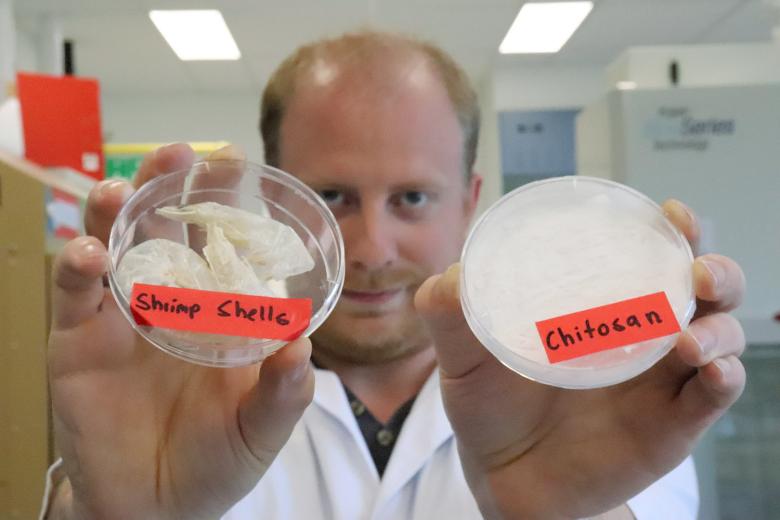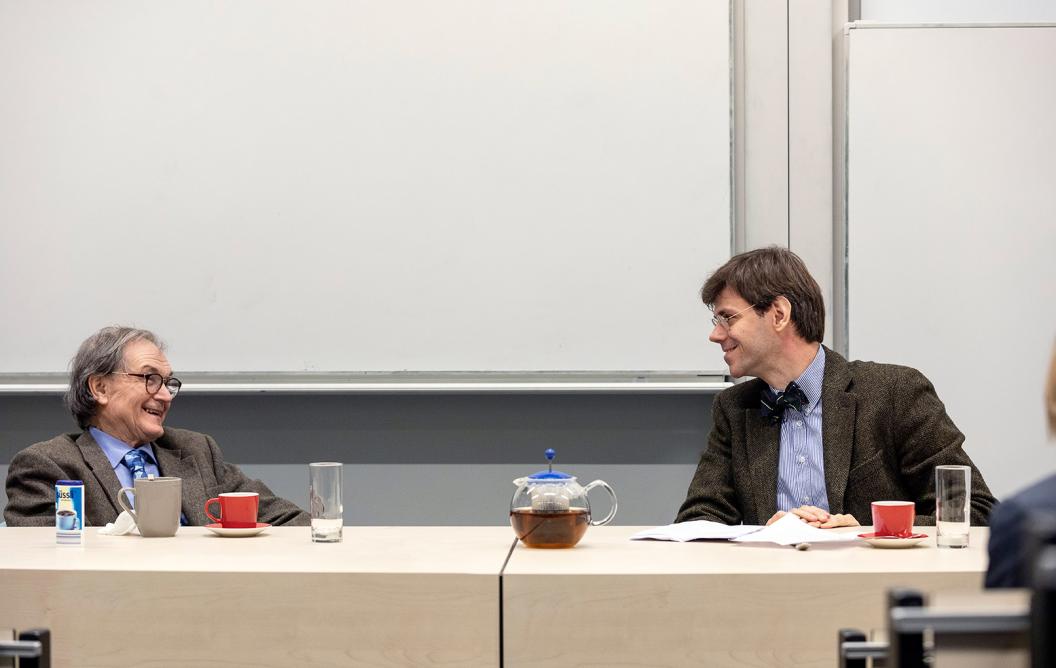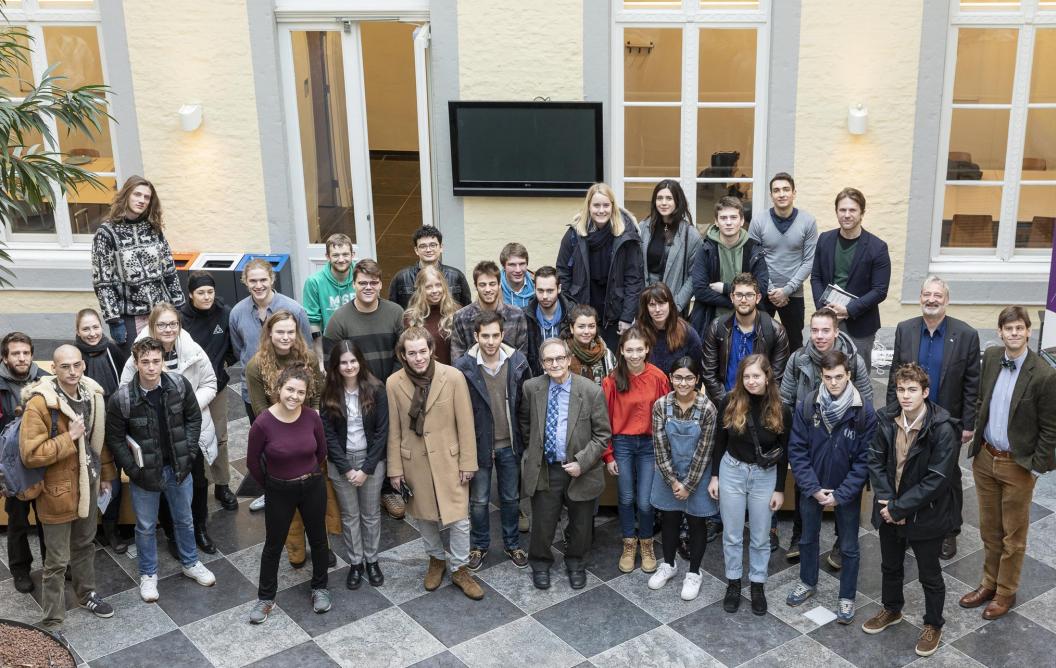The Road to Maastricht
| This article was re-published to celebrate Sir Roger Penrose's 2020 Nobel Prize in Physics. It describes his visit to Maastricht University in January 2019. |
What would you ask someone who, in the words of the organizers, played a major role in the story of science in the last 70 years? Precisely that opportunity presented itself to a small number of bachelor’s students, who engaged with Sir Roger Penrose in a Q&A session on a snowy January morning.
A small crowd watches in anticipation as Sir Roger Penrose makes himself comfortable in one of two blue leather chairs. UCM Professor Teun Dekker, who moderates the session, sits in the other.
“We are here with students from different bachelor’s programmes,” Dekker begins by addressing his guest. “University College Maastricht, the Maastricht Science Programme and Data Science and Knowledge Engineering. They all prepared questions to discuss with you today. I thought long about how I should introduce you. Do I talk about the papers, about the books?” Dekker turns his attention towards the students. “But then I thought: science is really about solving puzzles. It’s about giving colleagues and students the tools to answer the questions that bother them. Professor Penrose is someone who is really good at that.”
A two-day visit
The Q&A session is part of Professor Penrose’s two-day visit to the Faculty of Science and Engineering. A day earlier, he attended a symposium about physics and mathematics research at UM and gave a public lecture at Studium Generale. The latter event generated such a crowd that people had to sit on stairs and stand in the back of a fully packed auditorium. Afterwards, they patiently queued to ask for an autograph and take a picture with the famous scientist, right until the moment security cleared the building to close for the night.
Today’s intimate event paints a stark contrast with the evening before. About thirty students are present. The session kicks off with a discussion about whether quantum-mechanical systems can or cannot be simulated by a computer. After ten minutes of debate, Professor Dekker is the first to dare a joke: “Why would it be cool to subsume quantum mechanics under general relativity? Because then you can kill two birds with Ein Stein!” The room erupts with laughter at his unexpected deadpan delivery, Sir Roger Penrose included. “Oh, I never heard that! That’s a good one”, he chuckles. This comment, in turn, delights Professor Dekker. “Really? I’m so happy!”
Questions of science and being human
Make no mistake: while the atmosphere is jovial and relaxed, the Q&A does not shy away from exploring deep questions. Quantum mechanics is a recurring theme, as is the human experience. Can someone’s consciousness change such that they could be considered a different person? Has humanity been around long enough to measure natural constants, such as the speed of light, to be certain they are constant? What does that mean for physics? Upon hearing the students’ thoughts, Professor Penrose’s face frequently lights up with a smile.
A good portion of the questions focusses on the process of doing science. Sir Roger Penrose is known to hold unconventional views and to connect many different disciplines, which clearly intrigues the students in the room. “How do you find a way to build a new theory from scratch?”, asks one of them. Professor Penrose’s answer is perhaps as unorthodox as the theories that prompted the question. As an example, he tells an anecdote about his time as a PhD student. He got lost in thought while attending a lecture on superposition. “Fortunately, my mind wandered. Since I didn’t hear the explanation, I worried about the topic ever since.”
The Maastricht answer
While on the subject of teaching, another student chimes in with a pedagogical question. “Why do you think that different disciplines like physics, mathematics and philosophy are all taught separately? My opinion is that a lot of times, it makes sense to teach them together because they are so interconnected.” Professor Penrose: “There are two answers to this question, and they are contradictory. One is: if you want to make progress in science, you have to understand one small area extremely well. Then, maybe you can go a little further than other people have in that area. On the other hand, you’ve got to see what this area is in the context of physics, or mathematics, as a whole. So do you concentrate on a very specific area, or do you spread your interests broadly?”
…and animals?
In between deep discussions about consciousness, physics and the nature of reality, a remarkable number of creatures injected lightness into the conversation. Professor Dekker, for example, posed the question whether Sir Roger Penrose identified as a fox (“doing many small things”) or a hedgehog (“doing one big thing”) when it came to doing science. Professor Penrose settled for “a fox with spikes”.
Later on, a question about whether our perception influences what we consider the laws of the universe triggered a quirky side discussion. Which critters take over when man is no more? Octopuses were considered a feasible option (“very clever creatures”), but dolphins and elephants (“their trunks are pretty handy, much better than dolphin fins”) also entered the mix.
Professor Dekker has his own thoughts on the subject. “The Maastricht answer is very much to take the broad approach,” he says, “if you look at the teaching offered here. At least during the bachelor’s phase.” Professor Penrose: “I think there’s no general answer. In my case, I try to do both. I think it depends on who you are.”
Sir Roger Penrose
Briefly introducing Sir Roger Penrose can be a challenge. The British mathematical physicist, mathematician and philosopher of science has a long list of accomplishments to his name. He shared the Wolf Prize in Physics with Professor Stephen Hawking, for example, for their work on general relativity and the physics of black holes.
His influence is also apparent in art: so-called Penrose triangles, Penrose stairs and Penrose tilings feature prominently in the work of artists such as M.C. Escher. Furthermore, Sir Roger Penrose authored a number of popular scientific books.
Impressed (but sticking to the facts)
The broad and interdisciplinary teaching philosophy certainly showed during the Q&A session. When asked about his experiences with UM’s students, Sir Roger Penrose commented: “I was very impressed with them.” Keeping in line with the session’s discussions about the importance of describing reality, he immediately added: “Well, with the students I talked to. The ones I didn’t meet, I don’t know about them of course!”
The Road to Reality
|
Sir Roger Penrose’s visit to Maastricht was part of a longer visit to The Netherlands, which celebrated the Dutch translation of his book The Road to Reality (De Weg naar de Werkelijkheid). Dr. Ronald Westra (DKE) contributes to the text printed on the back cover of the book’s Dutch edition. “In The Road to Reality, Sir Roger Penrose takes us on an engaging journey to the ultimate laws of reality”, he writes. A podcast with Dr. Westra was also published for the occasion of the visit, in which he discusses physics research at UM among other topics (in Dutch). |
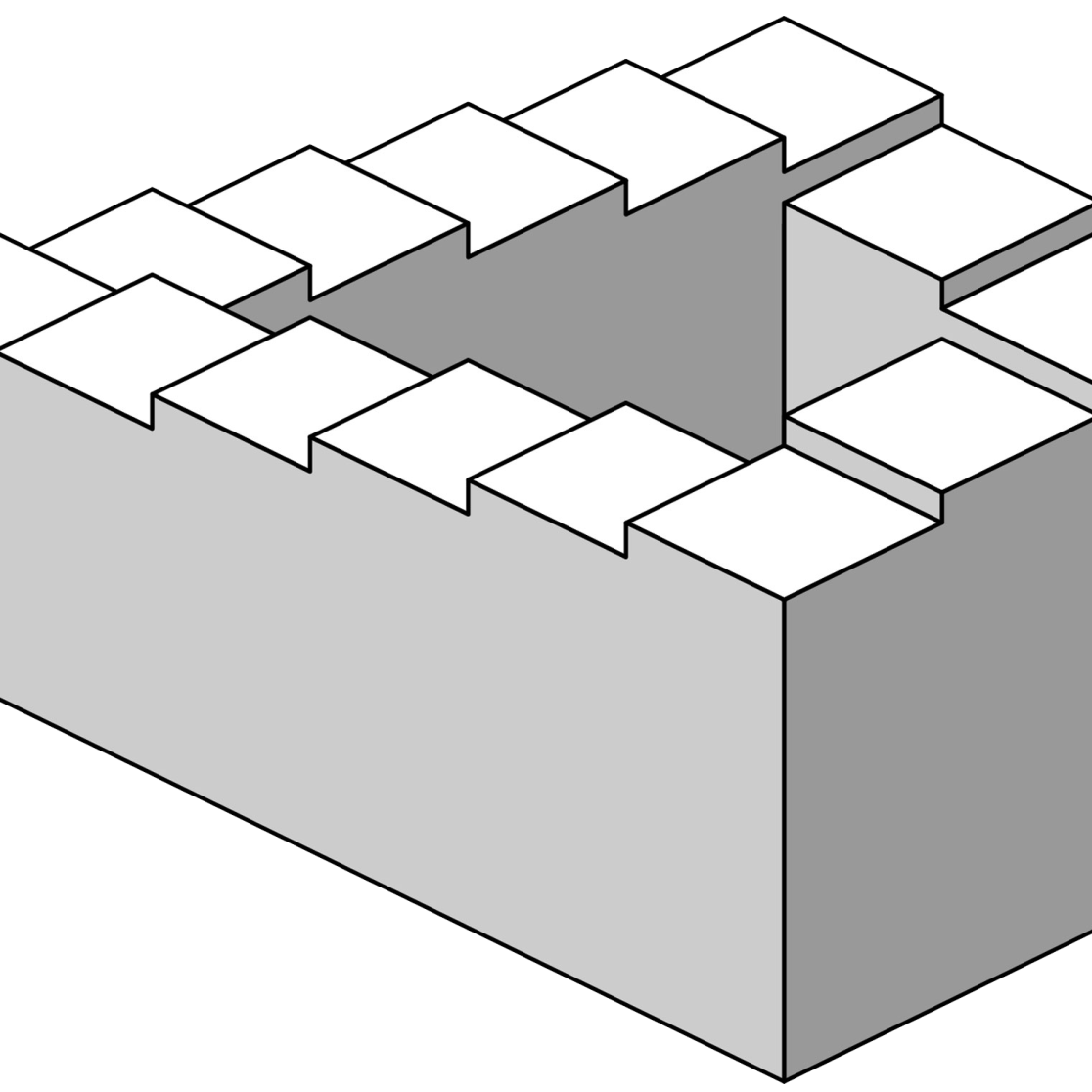
Also read
-
Machines that can improvise
Computers are already capable of making independent decisions in familiar situations. But can they also apply knowledge to new facts? Mark Winands, the new professor of Machine Reasoning at the Department of Advanced Computing Sciences, develops computer programs that behave as rational agents.

-
A second chance for plastic
If we were to replace plastic with paper or glass, would the environment benefit? Surprisingly, no, says professor of Circular Plastics Kim Ragaert. She is calling for an alternative approach aimed at increasing awareness of and knowledge about recycling.
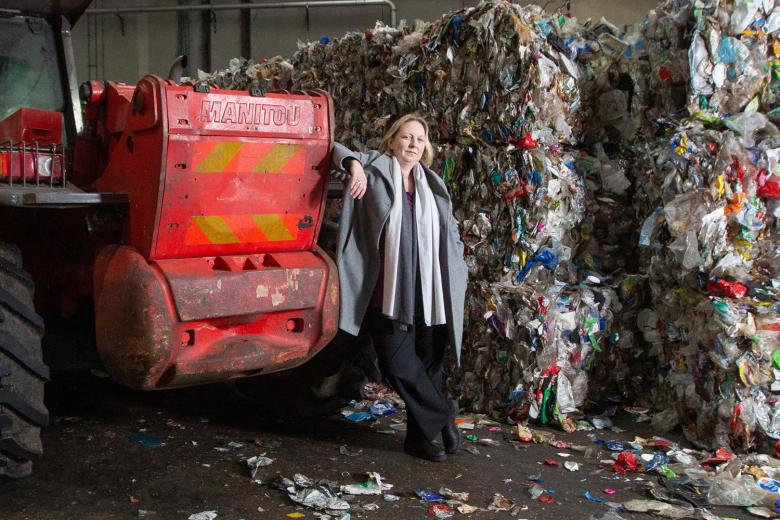
-
AMIBM: University collaboration at Brightlands
Eighty years ago, DSM opened its central laboratory for fundamental research in Geleen. Now the old lab is part of the Brightlands Chemelot Campus. This coming fall, the Festival Feel the Chemistry will look back on eighty years of innovation and will also look ahead to the future. Maastricht...
